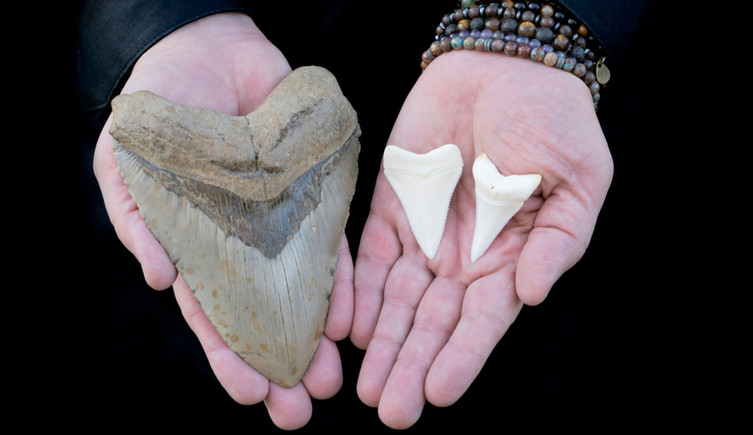Great white sharks and their ancestors may have helped drive the megalodon into extinction.
The dietary records contained in the fossilised teeth of great whites and megalodon suggest they could have been competing for the same prey.

The great white shark is among the largest living predatory fish, and is found across the oceans of the world. Image © wildestanimal/Shutterstock
Great white sharks and their ancestors may have helped drive the megalodon into extinction.
The dietary records contained in the fossilised teeth of great whites and megalodon suggest they could have been competing for the same prey.
The largest-ever shark might have been pushed to the brink of extinction with the help of a smaller relative.
A team of international researchers investigating the diet of Otodus megalodon found that the chemical signature of its diet locked within its fossilised teeth show that what it was eating overlapped with great white sharks.
The study, published in Nature Communications, suggests this could have contributed to megalodon dying out around 3.6 million years ago in the Pliocene.
Co-author Prof Michael Griffiths says, 'Our results show that both megalodon and its ancestor were indeed apex predators, feeding high up their respective food chains.
'But what was truly remarkable is that zinc isotope values from Early Pliocene shark teeth from North Carolina suggest largely overlapping trophic levels of early great white sharks with the much larger megalodon.'
Prof Kenshu Shimada, another co-author, adds, 'These results likely imply at least some overlap in prey hunted by both shark species.
'While additional research is needed, our results appear to support the possibility for dietary competition of megalodon with Early Pliocene great white sharks.'

The megalodon may have been up to three times as big as the biggest great white shark. Image © Mark_Kostich/Shutterstock
Studying the diet of a living species is relatively straightforward, but for extinct species working out what they ate is much more difficult.
Fossils can sometimes preserve the remains of a last meal, but such specimens are very rare, while comparisons with living relatives can be helpful, but may not be completely representative of an ancestor.
Instead, scientists turn to a variety of chemical and analytical techniques to discover what used to be on the menu. Analysis of preserved tissues such as hair can be used to identify the building blocks of proteins, which in turn can be used to infer the amount of meat or plants an animal might have eaten.
Examining teeth can also offer dietary clues through their shape and condition. For example, the presence of features such as cavities suggests a species ate a high amount of sugar, with the jawbones of the ancient mammal Microsyops latidens used to infer when they began to eat more fruit.
But beyond superficial details, a closer look at teeth can also prove revealing. The levels of different forms of the same element, known as isotopes, can be used to work out many details of an extinct organism's lifestyle, from their metabolic rate to their diet.
As shark skeletons are mostly made out of soft cartilage which rarely fossilises, most of our knowledge of these animals comes from their more solid teeth.
One isotope particularly common in teeth is zinc, which is found in both the hard enamel coating of teeth and the dentine layer underneath. Zinc is mostly obtained through diet, with differing proportions of zinc isotopes linked to what an animal eats and where in the food chain it sits.
Top predators have lower proportions of Zinc-66 compared to other isotopes in their body, because the muscle tissue which makes up a significant portion of their diet is low in this isotope. The lower the proportion of Zinc-66 in the body of an animal, the more likely it is to be higher up in the food chain.
As this method of comparison is still new, there have been relatively few studies using it to look at the diet of extinct organisms. With the abundance of fossilised shark teeth, the scientists behind the current study decided to investigate what this technique can reveal about these hunters of the deep.

Dr Jeremy McCormack isolates zinc from shark tooth samples in a metal-freelaboratory. Image © MPI for Evolutionary Anthropology
The researchers measured the proportion of different zinc isotopes in the teeth of a range of extinct and living species.
The researchers found that the zinc isotope ratios in Otodus sharks changed over time. The extinct Otodus chubutensis, which is believed to have evolved into the megalodon, had a low zinc isotope ratio during the Miocene around 16 million years ago.
But megalodon specimens in the Atlantic subsequently saw their proportion of Zinc-66 increase around five million years ago, suggesting they were no longer top of the food chain.
Over the same period of time, the equivalent zinc values for the great white shark and its ancestor remained broadly the same; at a similar value to O. chubutensis. This suggests that great white sharks became the apex predator of the Atlantic and may have outcompeted megalodon for food.
Both sharks could have been competing for the same prey, such as large whales. Given megalodon's size and resulting energy demands, a decline in the amount of prey available could have posed a significant threat to its survival.
However, only one location in North Carolina had teeth from both species allowing for meaningful comparison, making it difficult to ensure that the conclusions are representative of the situation across the entire Atlantic.
It does, however, add to mounting evidence that the extinction of megalodon was not due to one single factor. The combination of a decline in prey species, a changing climate, and increasing competition may have been enough to wipe out the largest ever shark.

Find out more about why we need to protect the oceans, find themed events, and read about the pioneering work of the Museum's marine scientists.
Don't miss a thing
Receive email updates about our news, science, exhibitions, events, products, services and fundraising activities. We may occasionally include third-party content from our corporate partners and other museums. We will not share your personal details with these third parties. You must be over the age of 13. Privacy notice.
Follow us on social media